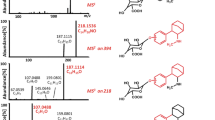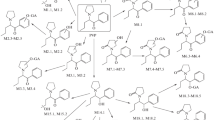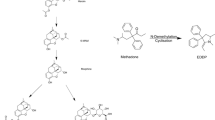Summary
A highly specific and sensitive method for the determination ofβ-phenylethylamine (PEA) in biological material is presented. It involves prepurification of the extracts on Sep-Pak C18 cartridges, derivatization with heptafluorobutyric acid anhydride, gas chromatography on 50 m capillary columns and quantification by chemical ionization mass spectrometry.
Using this method, levels of PEA in the rat brain and the effects of various monoamine oxidase (MAO) inhibitors thereon have been determined. PEA control levels were found to vary considerably: the lowest and highest values found were 0.4 and 12.5 ng/g tissue (n=25). Within one and the same control group, the variation was somewhat smaller. The preferential or specific inhibitors of MAO A, amiflamine, cimoxatone, CGP11305 A, moclobemide and toloxatone did not alter rat brain PEA even at high doses. In contrast, the preferential inhibitors of MAO B, deprenil, pargyline and MD 780236, as well as the nonselective agent tranylcypromine, caused strong (up to about 60-fold) increases. The threshold doses corresponded to those which caused about an 80 % inhibition of MAO B as measuredex vivo.
The method was also used to determine the concentration of PEA in human CSF (mean 17.3±3.3 ng/ml, range 3–45 ng/ml, n=15) and urine (males: mean 35±5μg/g creatinine, range 3.8–219μg/g, 78 control days of a total of 12 subjects; females: mean 35±6μg/g creat., range 2.7–266μg/g, 55 control days of a total of 8 subjects).
Similar content being viewed by others
References
Andersen, H., Braestrup, C.: Mass fragmentographic demonstration of low amounts ofβ-phenylethylamine in human urine. Scand.J. Lab. Invest.37, 33–37 (1977).
Antelman, S. M., Edwards, D. J., Lin, M.: Phenylethylamine: evidence for a direct, postsynaptic dopamine-receptor stimulating action. Brain Res.127, 317–322 (1977).
Beckmann, H., Reynolds, G. P., Sandler, M., Waldmeier, P., Lauber, J., Riederer, P., Gattaz, W. F.: Phenylethylamine and phenylacetic acid in CSF of schizophrenics and healthy controls. Arch. Psychiatr. Nervenkr.232, 463–471 (1982).
Bieck, P. R., Nilsson, E., Schick, C., Waldmeier, P. C., Lauber, J.: Urinary excretion of tryptamine in comparison to normetanephrine and beta-phenyl-ethylamine in human volunteers after subchronic treatment with different monoamine oxidase inhibitors. In: Neurobiology of the trace amines (Boulton, A. A., Baker, G.B., Dewhurst, W. G., Sandler, W., eds.), pp. 525–539. Humana Press Inc. 1984.
Blau, K., Claxton, I. M., Ismahan, G., Sandler, M.: Urinary phenylethylamine excretion: gas Chromatographic assay with electroncapture detection of the pentafluorobenzoyl derivative. J. Chromatogr.163, 135–142 (1979).
Boulton, A. A., Milward, I.: Separation, detection and quantitative analysis of urinaryβ-phenylethylamine. J. Chromatogr.57, 287–296 (1971).
Coutts, R. T., Baker, G. B., LeGatt, D. F., McIntosh, G. J., Hopkinson, G., Dewhurst, W. G.: Screening for amines of psychiatric interest in urine using gas chromatography with electron-capture detection. Progr. Neuro-Psychopharmacol.5, 565–568 (1981).
Durden, D. A., Philips, S. R., Boulton, A. A.: Identification and distribution ofβ-phenylethylamine in the rat. Can. J. Biochem.51, 995–1002 (1973).
Edwards, D. J., Doshi, P. S., Hanin, I.: Analysis of phenylethylamines by gas chromatography-chemical ionisation mass spectrometry. Anal. Biochem.96, 308–316 (1979).
Fawcett, J., Sabelli, H., Gusovsky, F., Epstein, P., Javaid, J., Jeffriess, H.: Phenyl-ethylaminic mechanisms in maprotiline antidepressant effect. Fed. Proc.42, 1164 (abstr. 5110) (1983).
Felner, A. E., Waldmeier, P. C.: Cumulative effects of irreversible MAO inhibitorsin vivo. Biochem. Pharmacol.28, 995–1002 (1979).
Grob, K., Grob, G.: Capillary columns with immobilized stationary phases. II.Practical advantages and details of procedure. J. Chromatogr.213, 211–221 (1981).
Grob, K., Grob, G., Grob, K.: Capillary columns with immobilized stationary phases. J. Chromatogr.211, 243–246 (1981).
Hopkinson, G., Baker, G. B., Douglass, A. B., McKim, H. R., Dewhurst, W. G.: Analysis of urinary excretion patterns of bioactive amines and their metabolites in normal control subjects.Progr. Neuro-Psychopharmacology6, 495–498 (1982).
Kamata, S., Imura, K., Okada, A., Kawashima, T., Yamatodani, A., Watanabe, T., Wada, H.: Simultaneous analyses of phenethylamine, phenylethanolamine, tyramine and octopamine in rat brain using fluorescamine. J. Chromatogr.231, 291–299 (1982).
Karoum, F., Nasrallah, H., Potkin, S., Chuang, L., Moyer-Schwing, J., Phillips, I., Wyatt, R. J.: Mass fragmentography of phenylethylamine, m- and p-tyramine and related amines in plasma, cerebrospinal fluid, urine and brain. J. Neurochem.33, 201–212 (1979).
Maitre, L., Felner, A., Waldmeier, P., Kehr, W.: Monoamine oxidase inhibition in brain and liver of rats treated with chlordimeform. J. Agric. Food Chem.26, 442–446 (1978).
Martin, I. L., Baker, G. B.: A gas-liquid Chromatographic method for the estimation of 2-phenylethylamine in rat brain tissue. Biochem. Pharmacol.26, 1513–1516 (1977).
Narasimhachari, N., Friedel, R. O.: Quantitation of biologically important primary amines as their isothiocyanate derivatives by gas chromatography using nitrogen detector and validation by selected ion monitoring. Clin. Chim. Acta.110, 235–243 (1981).
Philips, S. R., Boulton, A. A.: The effects of monoamine oxidase inhibitors on some arylalkylamines in rat striatum. J. Neurochem.33, 159–167 (1979).
Potkin, S. G., Karoum, F., Chuang, L. W., Cannon-Spoor, H. E., Phillips, I., Wyatt, R. J.: Phenylethylamine in paranoid chronic schizophrenia. Science206, 470–471 (1979).
Reynolds, G. P.: Phenylethylamine-a role in mental illness? TINS2, 265–268 (1979).
Reynolds, G. P., Gray, D. O.: A method for the estimation of 2-phenylethylamine in human urine by gas chromatography. Clin. Chim. Acta70, 213–217 (1976).
Reynolds, G. P., Rausch, W. D., Riederer, P.: Effects of tranylcypromine stereoisomers on monoamine oxidation in man. Br. J. Clin. Pharmacol.9, 521–523 (1980).
Saavedra, J. M.: Enzymatic isotopic assay for and presence ofβ-phenylethylamine in brain.J. Neurochem.22, 211–216 (1974).
Sabelli, H. C., Fawcett, J., Gusovsky, F., Javaid, J., Edwards, J., Jeffriess, H.: Urinary phenyl acetate: a diagnostic test for depression? Science220, 1187–1188 (1983).
Sandler, M., Ruthven, C. R., Goodwin, B. L., King, G. S., Pettit, B. R., Reynolds, G. P., Tyrer, S. P., Weller, M. P., Hirsch, S. R.: Raised cerebrospinal fluid phenylacetic acid concentrations: preliminary support for the phenylethylamine hypothesis of schizophrenia? Commun. Psychopharmacol.2, 199–202 (1978).
Schweitzer, J. W., Friedhoff, A. J., Schwartz, R.: Phenethylamine in normal urine: failure to verify high values. Biol. Psychiat.10, 277–285 (1975).
Slingsby, J. M., Boulton, A. A.: Separation and quantitation of some urinary arylalkylamines. J. Chromatogr.123, 51–56 (1976).
Sloviter, R. S., Connor, J. D., Drust, E. G.: Serotonergic properties ofβ-phen-ethylamine in rats. Neuropharmacology19, 1071–1074 (1980).
Suzuki, S., Yagi, K.: A fluorometric assay ofβ-phenylethylamine in rat brain. Anal. Biochem.75, 192–200 (1976).
Suzuki, S., Yagi, K.: A fluorometric assay ofβ-phenylethylamine in human urine. Clin. Chim. Acta78, 401–410 (1977).
Suzuki, O., Hattori, H.: Determination ofβ-phenylethylamine as its isothio-cyanate derivative in biological samples by gas chromatography mass spectrometry. Biomed. Mass Spectrom.10, 430–433 (1983).
Waldmeier, P. C., Antonin, K. H., Feldtrauer, J. J., Grunenwald, C., Paul, E., Lauber, J., Bieck, P.: Urinary excretion of O-methylated catecholamines, tyramine, and phenylethylamine in human volunteers treated with tranylcypromine and CGP 11305 A. Eur. J. Clin. Pharmacol.25, 361–368 (1983).
Waldmeier, P. C., Felner, A. E., Lauber, J.: Reversible monoamine oxidase inhibitors: relation between effects on enzymatic activity measuredex vivo and on amine metabolism. In: Monoamine oxidase and disease: prospects for therapy with reversible inhibitors (Dostert, P., Strolin-Benedetti, M., Tipton, K. F., eds.). London: Academic Press. 1984 (in press).
Willner, J., Lefevre, H. F., Costa, E.: Assay by multiple ion detection of phenyl-ethylamine and phenylethanolamine in rat brain. J. Neurochem.23, 857–859 (1974).
Author information
Authors and Affiliations
Rights and permissions
About this article
Cite this article
Lauber, J., Waldmeier, P.C. Determination of 2-phenylethylamine in rat brain after MAO inhibitors, and in human CSF and urine by capillary GC and chemical ionization MS. J. Neural Transmission 60, 247–264 (1984). https://doi.org/10.1007/BF01249097
Received:
Revised:
Issue Date:
DOI: https://doi.org/10.1007/BF01249097




